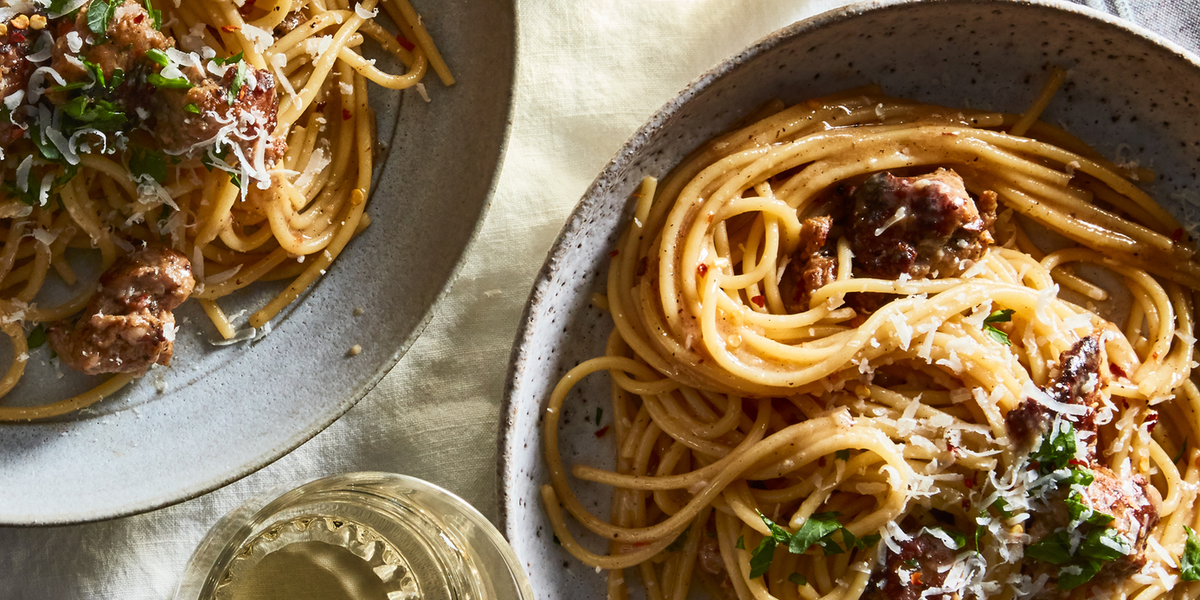
Conventional pasta-boiling wisdom for much of my life was along the lines of: the roomier the pot and the more water, the better—like, way better. And the water should already be at a rolling boil when the noodles are added (butta la pasta and all that). I was always told that a standard box of dried spaghetti needed about five to six quarts of water, to keep it fully submerged, and to provide enough space so that it wouldn't clump together into a sticky ball.
Somewhere along the way, I was clued into the fact that after cooking spaghetti super al dente, I should finish the noodles along with the sauce, plus a hefty splash of the starchy cooking water, for maximum emulsion and sauce binding. Which is a neat trick—and one I'd later learn to take even further.
In 2009, food scientist Harold McGee posed a question in The New York Times that changed my life: How much water does pasta really need? So heartened by his experiments with less cooking water (no sign of the feared-for glueiness) was McGee that he actually reached out to pasta legends Lidia Bastianich and Marcella Hazan, to ask them to give it a go. Ultimately, McGee found that he actually preferred not only cooking his noodles in less water, but even starting with cold water, so that the individual noodles didn't stick together too much. He noted that the resulting cooking water was much thicker than what you'd get with the old-school quarts-upon-quarts boiling method, calling it "almost a sauce in itself."
Some months later, Serious Eats' J. Kenji López-Alt got on the case after he walked in on his wife—gasp—cooking noodles at a mere simmer, in a small saucepan. He explains the science behind starchy pasta water of any kind in the first place:
Pasta is made up of flour, water, and sometimes eggs. Essentially, it's composed of starch and protein, and not much else. Now starch molecules come aggregated into large granules that resemble little water balloons. As they get heated in a moist environment, they absorb more and more water until they finally burst, releasing the starch molecules into the water... The starch eventually washes away into the water (assuming that you separated the pieces of pasta by stirring), and the pasta pieces become individuals again.
So, it makes sense that less water equates to a higher starch content for the same quantity of noodles. And, as López-Alt explains, starch acts as an emulsifier as well as a thickener—meaning it helps to keep fat molecules dispersed and suspended in a sauce, creating something light in texture and creamy-seeming, which coats the noodles as best as possible.
Ten years after McGee wrote about his initial tests, I'm still turning to this method of cooking my noodles whenever I need extra emulsion insurance. Like, when I want a thick, creamy coating for my pasta without any cream or butter—just pasta water—and I want it to come together quickly. I place my noodles, a bunch of salt, and cold water in a shallow skillet or saucepan, and bring it to a boil. From there, it only takes a few minutes to achieve a perfect al dente, with super starchy water to boot.
When I recently had mind-bogglingly creamy and delicious aglio e olio—spaghetti with just garlic, red pepper flakes, olive oil, and Parmesan—at New York's I Sodi, I knew I had to call in this trick to assuage my cravings at home. Most versions of aglio e olio ask you to cook down the pasta water for the sauce, so using a shallow skillet for the thickest, starchiest version of that water was a no-brainer.
The rendition I came up with riffs on the classic by adding deeply browned Italian sausage, and using some of its rendered fat along with the oil to cook the garlic. It's creamy, satisfying, and slightly spicy—and best of all, it takes only 15 minutes:
Spaghetti Aglio e Olio e Salsiccia (Spaghetti With Garlic, Olive Oil & Sausage)
View RecipeIngredients
| 1 | pound dried spaghetti |
| 2 | tablespoons extra-virgin olive oil, plus 2 tablespoons |
| 1 | pound (roughly 450 grams) sweet Italian sausage (3 or 4 depending on size), uncased |
| 1/4 | cup finely minced garlic (from about 6 to 8 cloves) |
| 1 | tablespoon red chili flakes |
| 1 | cup very finely grated Parmesan (about 2.5 ounces), plus more for garnish |
| 3/4 | cup finely chopped parsley, packed, plus more for garnish |
| 1 | teaspoon kosher salt, plus more to taste |
| 1 | pound dried spaghetti |
| 2 | tablespoons extra-virgin olive oil, plus 2 tablespoons |
| 1 | pound (roughly 450 grams) sweet Italian sausage (3 or 4 depending on size), uncased |
| 1/4 | cup finely minced garlic (from about 6 to 8 cloves) |
| 1 | tablespoon red chili flakes |
| 1 | cup very finely grated Parmesan (about 2.5 ounces), plus more for garnish |
| 3/4 | cup finely chopped parsley, packed, plus more for garnish |
| 1 | teaspoon kosher salt, plus more to taste |
What's your go-to weeknight pasta? Let me know in the comments!

0 comments